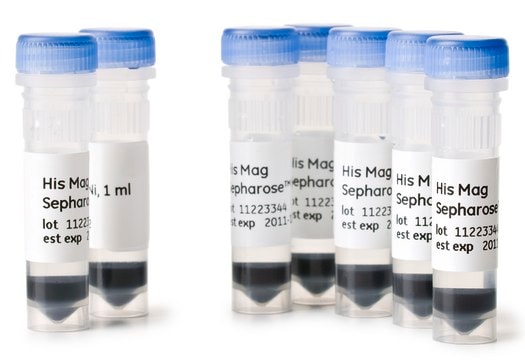A6861
Acetyl-CoA carboxylase 2 human
recombinant, expressed in Sf9 cells
Synonym(s):
ACACB, ACC2, acetyl-CoA carboxylase beta
Sign Into View Organizational & Contract Pricing
All Photos(1)
About This Item
Recommended Products
Application
Acetyl-CoA carboxylase is responsible for synthesis of Malonyl-CoA which is an inhibitor of fatty acid oxidation in skeletal muscle mitochondria. The enzyme may be used to study the effect on production of malonyl-CoA as well as fatty acid oxidation during exercise. The enzyme also may be used for ACC regulation study in anti-obesity and anti-type 2 diabetes therapeutics.
Biochem/physiol Actions
Acetyl-CoA Carboxylase (ACC) regulates the metabolism of fatty acids. This enzyme catalzes the formation of Malonyl CoA through the irreversible carboxylation of acetyl CoA. There are two main isoforms of Acetyl-CoA carboxylase expressed in mammals, Acetyl-CoA carboxylase 1 (ACACA) and Acetyl-CoA carboxylase 2 (ACACB). ACACA has broad tissue distribution but is enriched in tissues critical for fatty acid sythesis such as adipose tissue. ACACB is enriched in tissues such as skeletal muscle and heart that are critical for fatty acid oxidation.
The Acetyl-CoA Carboxylase enzymes are activated by citrate, glutamate, and dicarboxylic acids and negatively regulated by long and short chain fatty acyl CoAs. Because of thier roles in fatty acid metabolism and oxidation, ACACA and ACACB are therapeutic targets for treating obesity and metabolic syndrome disorders.
The Acetyl-CoA Carboxylase enzymes are activated by citrate, glutamate, and dicarboxylic acids and negatively regulated by long and short chain fatty acyl CoAs. Because of thier roles in fatty acid metabolism and oxidation, ACACA and ACACB are therapeutic targets for treating obesity and metabolic syndrome disorders.
Physical properties
C-terminal HIS-tagged 277 kDa full length protein
Unit Definition
One unit will cause the carboxylation of 1 picomole of acetyl-CoA per minute at pH 7.4 at 30 deg C.
Physical form
Buffered aqueous solution containing Tris-HCl, pH 8.0, NaCl, glycerol, and DTT. May also contain one or more of the following: EDTA, KCl, imidazole, TWEEN-20.
Preparation Note
Thaw on ice. Upon first thaw, briefly spin tube containing enzyme to recover full content of the tube. Aliquot enzyme into single use aliquots. Store remaining undiluted enzyme in aliquots at -70°C. Note: Enzyme is very sensitive to freeze/thaw cycles.
Storage Class Code
12 - Non Combustible Liquids
WGK
WGK 1
Flash Point(F)
Not applicable
Flash Point(C)
Not applicable
Certificates of Analysis (COA)
Search for Certificates of Analysis (COA) by entering the products Lot/Batch Number. Lot and Batch Numbers can be found on a product’s label following the words ‘Lot’ or ‘Batch’.
Already Own This Product?
Find documentation for the products that you have recently purchased in the Document Library.
W W Winder et al.
The American journal of physiology, 270(2 Pt 1), E299-E304 (1996-02-01)
Malonyl-CoA, an inhibitor of fatty acid oxidation in skeletal muscle mitochondria, decreases in rat skeletal muscle during exercise or in response to electrical stimulation. Regulation of rat skeletal muscle acetyl-CoA carboxylase (ACC), the enzyme that synthesizes malonyl-CoA, was studied in
Lutfi Abu-Elheiga et al.
Proceedings of the National Academy of Sciences of the United States of America, 100(18), 10207-10212 (2003-08-16)
Malonyl-CoA, generated by acetyl-CoA carboxylases ACC1 and ACC2, is a key metabolite in the control of fatty acid synthesis and oxidation in response to dietary changes. ACC2 is associated to the mitochondria, and Acc2-/- mice have a normal lifespan and
Morgan D Fullerton et al.
Nature medicine, 19(12), 1649-1654 (2013-11-05)
The obesity epidemic has led to an increased incidence of nonalcoholic fatty liver disease (NAFLD) and type 2 diabetes. AMP-activated protein kinase (Ampk) regulates energy homeostasis and is activated by cellular stress, hormones and the widely prescribed type 2 diabetes
Sihao Liu et al.
Nature, 502(7472), 550-554 (2013-10-25)
Food intake increases the activity of hepatic de novo lipogenesis, which mediates the conversion of glucose to fats for storage or use. In mice, this program follows a circadian rhythm that peaks with nocturnal feeding and is repressed by Rev-erbα/β
Graeme J Gowans et al.
Cell metabolism, 18(4), 556-566 (2013-10-08)
While allosteric activation of AMPK is triggered only by AMP, binding of both ADP and AMP has been reported to promote phosphorylation and inhibit dephosphorylation at Thr172. Because cellular concentrations of ADP and ATP are higher than AMP, it has
Our team of scientists has experience in all areas of research including Life Science, Material Science, Chemical Synthesis, Chromatography, Analytical and many others.
Contact Technical Service







